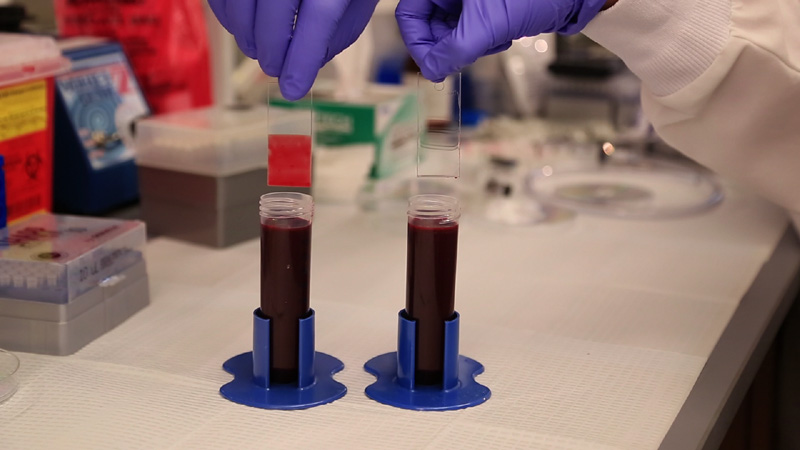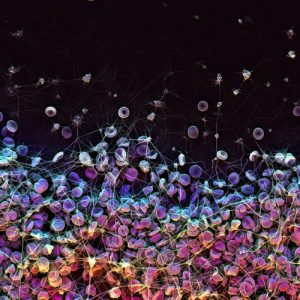Professor Ben Hatton and colleagues create new materials coating that prevents blood clots
[sharexy]

Photo: glass slides dipped in blood to demonstrate the effectiveness of the non-stick coating material – the sample on the right shows minimal blood clotting on the coated surface in contrast to the un-coated sample on the left (photo: Wyss Institute for Biologically Inspired Engineering, Harvard University)
October 21, 2014
The ability for blood to clot is our body’s first line of defense when it comes to wounds and exposure to foreign objects. However, this response can be problematic or even life-threatening when trying to keep blood from coagulating in medical devices such as catheters, dialysis equipment, heart-lung machines, or a new generation of microfluidic diagnostic tools. Blood thinners are often used in these situations, but they can have serious side-effects for patients who are elderly, sick or severely wounded.
Making an inert surface for blood contact is really a huge benefit for a wide range of medical procedures – this is going to make everybody’s life a whole lot easier in the medical community and for patients

Dr. Benjamin Hatton, an assistant professor in the University of Toronto’s department of materials science and engineering, along with his research colleagues at the Wyss Institute for Biologically Inspired Engineering at Harvard University, have recently engineered a surface coating material that prevents blood from clotting, without the use of anticoagulants.
The coating makes use of a uniquely designed microstructured surface that is matched to the chemical composition of perfluorcarbons – a liquid similar to Teflon that does not mix with any other types of liquids. The result is an ultra-low adhesion, slippery material that essentially repels all other liquids, including the components of blood and micro-organisms like bacteria.

In addition to successfully testing the coating on over 20 different medical surfaces, the research team also ran in vivo tests. They implanted medical-grade tubing and catheters coated with the material to carry blood through an artery-to-vein ‘shunt’ in a pig, and demonstrated minimal blood clotting for at least the eight hours without the use of blood thinners. And out of sheer curiosity, the researchers also showed that a gecko – whose footpads are well known for its adhesive strength – was also unable to stick to the coated surface.
“Making an inert surface for blood contact is really a huge benefit for a wide range of medical procedures – we really just want blood to ignore that surface and not clot,” said Professor Hatton in a recent CBC Quirks & Quarks interview. “I think this is going to make everybody’s life a whole lot easier in the medical community and for patients as well.”
You can listen to Professor Hatton discuss this research, published recently in Nature Biotechnology, with Bob McDonald on CBC’s Quirks & Quarks (October 18 episode) – Material is Bloody Slippery.